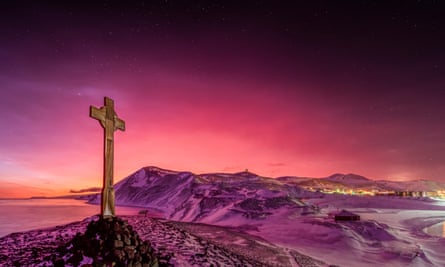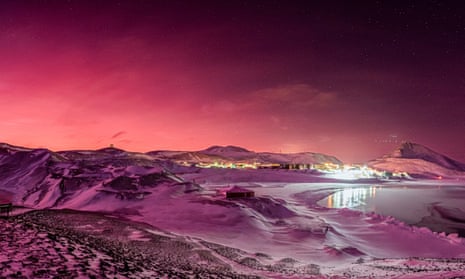The great white continent of Antarctica has been awash in dazzling pink and plum hues, thanks to the “afterglow” effect of the Tongan eruption.
The unusually fiery skies have already been reported across New Zealand and Australia in the past month, which scientists put down to a spike in aerosols that were hurled up into the stratosphere following the Hunga Tonga-Hunga Ha’apai volcanic eruption in January.
Scientists working in Antarctica reported the phenomenon to New Zealand’s National Institute of Water and Atmospherics (Niwa) after realising the same thing was happening in the southernmost region of the world.

“Usually in mid-winter, Antarctica is nearly continuously dark, except for a slight ‘nautical twilight’ at around midday, which means the horizon is faintly visible in good conditions,” said Stuart Shaw, a science technician with Antarctica New Zealand, who is stationed at Scott Base for the winter and who captured stunning images of the blazing skies.
“But this year, we were presented with quite a show, which had most of the station personnel grabbing jackets and running outside with their cameras to look at the awesome colours.
“Believe it or not, I haven’t edited these colours either, they are pretty much as we saw them,” Shaw said. “It’s incredible.”
Data from satellite lidar – a laser radar – shows there is an abundance of aerosols in the stratosphere above Antarctica, which were not there prior to the eruption, said Nava Fedaeff, a forecaster at Niwa.
“Stratospheric aerosols can circulate the globe for months after a volcanic eruption, scattering and bending light as the sun dips or rises below the horizon, creating a glow in the sky with hues of pink, blue, purple and violets.”

The volcanic twilights are known as “afterglows”, with the colour and intensity dependent on the amount of haze and cloudiness along the path of light reaching the stratosphere, she said.
While Antarctica is roughly 7,000km from Tonga, “we share the same skies”, said Jordy Hendrikx, Antarctica New Zealand’s chief science adviser.
“Much of the science that we support aims to understand those dynamics in the atmosphere, oceans and ecosystems, and to help better understand the connectivity between Antarctica, New Zealand and the wider world.”
